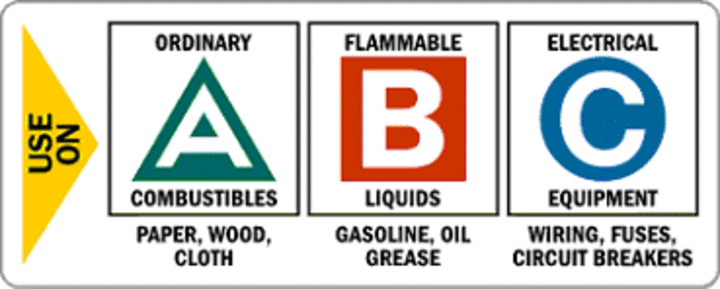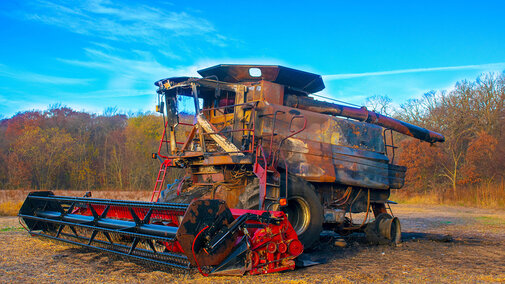As we move into fall harvest, a large percentage of Nebraska is in moderate to exceptional drought conditions (Figure 1). Fire is of high concern due to weather conditions conducive for fires to move quickly throughout the landscape.

Beyond conducive weather conditions, equipment has changed dramatically over the last couple of decades. Compared to older machines, today’s equipment is bigger, more complex, and carries more oil and fuel. On combines, shields, panels and fuel tanks used to be made out of metal but are now mostly synthetic, which can easily catch on fire. When smoldering crop residue meets a hydraulic leak or fuel, a fire quickly starts and spreads throughout the machine.
It is important to note that improvements have been made on newer equipment to reduce fires. Radiator fans have increased in power over the years, with many spinning at 60 mph to keep debris off hot engine components.
For example, John Deer moved the air intake of the radiator on its 70 series combine to the top in 2007, compared to the 60 series where the air intake was lower down on the side, allowing flammable crop residue to more easily enter.
A study of about 9,000 combine fires completed several years ago confirmed that crop residue typically starts the fire by coming into contact with hot manifold, exhaust or turbocharger. The majority of fires — 76.7% — start in the engine area of the combine (Venem, M.T. et al 2002). However, the most devastating fires spread rapidly to other areas of the machine.
Fires become especially severe when fuel lines rupture from the heat or when a fire burns through a hydraulic hose. Soon the combine becomes an inferno, especially if the engine is still pumping out fuel or hydraulic fluid under pressure. Typically, when fires ignite one or more tires, the result is complete loss of the machine. Availability of fire extinguishers and quick response from local fire departments can prevent total loss.
The following is a guide that can help ensure a smoother and safter harvest season without fire emergencies.
Preventing Combine Fires
Keep Combines Clean
Keeping your equipment clean is the best way to prevent fires, especially around the engine, turbo charger and exhaust system. Keep in mind that the majority of fires are caused by crop residue. It is easy for crop residue to accumulate on the engine, wiring harnesses, lights and other cracks and crevices. The majority of combine manufactures recommend cleaning the machine after shutting down at the end of the day at least. Battery or gas-powered leaf blowers are great tools to provide high quantities of air to move debris off the machine while out in the field. If machines are returned to the shop between fields, large air compressors can also be used to clean machines.
Also consider power-washing to remove grease and oil, which can allow a small fire to spread rapidly. By removing excess grease and oil, this aids in improving machine efficiency and keeps equipment cool. The exhaust components and turbochargers can reach 1,000-1,200oF, with surface temperatures reaching around 900oF. Crop residues have been reported to ignite at approximately 500oF and above.
Don’t Park Equipment Near Flashy Fuels
Let combines cool down before parking them inside a machine shed after harvesting all day. If leaving the combine in the field at the end of the day, try to park on a fire-resistant surface rather than in the middle of a harvest field. Sparks and malfunctions can occur at any time, and crop debris can continue to smolder if the machine is not cleaned at the end of the day. Parking combines in a recently disked part of the field or a grassy area away from standing stubble and the unharvested crop is advised. Alternately, consider disking a fire break around parked equipment if parking in areas with heavy fire fuels.
Reduce Combine Engine Load
Increasing harvest speed and putting combine engines under a lot of stress increases the chances of fires. It is important to note that new combine engines have been designed to meet new emission standards, which has resulted in higher engine temperatures. The new exhaust systems use diesel particulate filters to trap pollutants. As the filter become filled with pollutants, the engine cleans the filter by burning the soot out. In return, we get a very clean but extremely hot exhaust, especially during diesel particulate filter regenerations.
Keep Bearings Cool
A study out of Spain conducted in 2018 and 2019 found that bearings and belts caused 18% of combine fires. One way to ensure bearings are operating efficiently and staying cool is using an infrared thermometer with lasers, which can be purchased for around $50.
Check bearings once the machine has warmed up. Bearings typically run between 125-150oF. Once bearings are reaching temperatures above 180oF, damage can occur. If bearing reach temperatures above 300oF, shut the machine off immediately.
Avoid Harvesting During Extreme Fire Weather
Postponing harvest because weather is conducive for fires when it is hot, dry and strong winds are occurring can be very challenging. A study conducted by Venem, M.T., et al found that 48.5% of combine fires occurred between 2 p.m. and 4 p.m. when temperatures have peaked, and relative humidity is the lowest. Days when wind speed is greater than 20 mph, temperatures are at or above 90oF and relative humidity below is 30% are more conducive to combine fires and crop fires.
Preparation Before a Fire Happens
- Start harvesting a field on the downwind side. If a fire does occur, the flames will be pushed toward the harvested portion of the field.
- Always carry a cell phone or alternative for communicating with others in case of a fire.
- Carry a minimum of one 10 lb ABC dry chemical fire extinguisher (Figure 2) stored in or near the cab of the combine if the fire can be easily reached from the ground. Do not climb onto a burning machine to put it out. It is not worth the risk of the loss of your life or severe injury.
- Remember to PASS when using the extinguisher:
- Pull the pin.
- Aim the nozzle.
- Squeeze the trigger.
- Sweep across the base of the fire.
- Note: All fire extinguishers should be checked by the fire department or other agency annually to ensure they are fully charged and ready. Once an extinguisher has been used, it must be recharged. During the harvest season, invert and shake the extinguisher canister once or twice to prevent machine vibration from consolidating the dry chemicals at the bottom of the canister.
- Know the location of the field in relationship to letter or numbers on county roads.
- Have a tractor hooked to a disk near the field you are harvesting but located where it wouldn’t be affected if a field fire should occur.
- Have a large water tank with water near at the field.

Putting Out a Fire
- Immediately pull the machine, if possible, into adjacent areas that have already been harvested.
- Turn the machine off. The air intake systems and fans keep providing oxygen to the flames if machine continues running.
- Call 911 before trying to extinguish the fire yourself. Depending on your location, it may take up to 30 minutes or longer before the fire department can reach the scene. The sooner they are aware, the sooner they can be on-scene. Adrenaline is flowing but provide dispatch with as much detail regarding your location as possible. Include county road names and numbers or precise description, i.e., five miles east and four miles north of Farmer Brown’s house. The advantage of volunteer fire departments is their knowledge of where people live in the area. However, several departments called out to a fire located “northeast of town” must look for the smoke to locate the fire and can be delayed.
- If a combine fire is beyond control, focus on keeping it from spreading to the surrounding vegetation by either putting a disc line around it or wetting down the surrounding area.
Summary
Even with all the machine maintenance, sanitation, preparedness and awareness, fires can still occur. Key points to remember:
- Clean the machine of crop residue at least once a day.
- Be aware of the risk with higher engine/exhaust temperatures on today’s engines.
- Make sure everyone on the harvesting crew can communicate with each other.
- Park equipment in areas devoid of potential fire fuels if possible.
- Monitor bearing temperatures and replace when getting too hot.
- Have a tractor hooked to a disk or water tanks located at the field when fire risks are high.
- No piece of equipment is worth risking your life for.
References
Hamburg, D.L. 2011. Combine Fires Plague South Dakota Farmers. SDSU Igrow. Available at http://igrow.org. Accessed 9 Sep 2022.
Val, J., M. Videgain, P. Martin-Ramos, M. Cortés, A. Boné-Garasa, and F. Ramos. 2019. Fire Risks Associated with Combine Harvesters: Analysis of Machinery Critical Points. Agronomy, 9(12):877.
Venem, M.T., W. Gilbert and J. Shutske. 2002. Combine Fire Prevention Summit. ASAE Paper No. 028017. St. Joseph, Mich.: ASAE.

